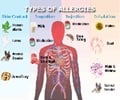Environment has a much stronger role than genetics in eosinophilic esophagitis (EoE), a severe, often painful food allergy that renders children unable to eat a variety of foods.

In an international collaboration involving multiple institutions, researchers at Cincinnati Children's Hospital Medical Center quantified the risk associated with genes and environment on familial clustering of EoE.
The researchers constructed and examined patient family pedigrees of patients with EoE and their first-degree relatives (nuclear family analysis) and of patients with EoE and their identical or fraternal twin/triplets (twin analysis). Using these two distinct analyses, they determined that 2.4% of siblings and 1.8% of first-degree relatives of patients with EoE also had EoE.
The researchers also found that brothers, fathers, and males were more likely to have EoE than sisters, mothers, or females. Twins had 20-40% risk of EoE depending upon whether they were identical or fraternal.
"The power of this study is the twin analysis," says Eileen Alexander, PhD, MS, BSN, RN, Woodside Fellow at Cincinnati Children's and first author of the study. "Both the twin and family analyses support that genetics contribute to EoE risk, but the twin analysis revealed that the contribution of genetics was previously overestimated, masking the stronger contribution of common household environment. Further studies of environmental factors may identify modifiable environmental risk factors that could be targeted for EoE prevention."
This study, published online September 22 in Journal of Allergy and Clinical Immunology, is the first EoE heritability study to analyze twins. This is a necessary step in separating the contribution of genetics from environment. It also identified a few environmental risk factors, including food allergies, high twin birth-weight difference, and self-reported penicillin allergy.
Advertisement
EoE can affect people of any age, but is more common among young men who have a history of other allergic diseases, such as asthma and eczema. EoE is often first discovered in children with feeding difficulties and failure to thrive, but it is often misunderstood and not well known, delaying proper diagnosis and treatment.
Advertisement















